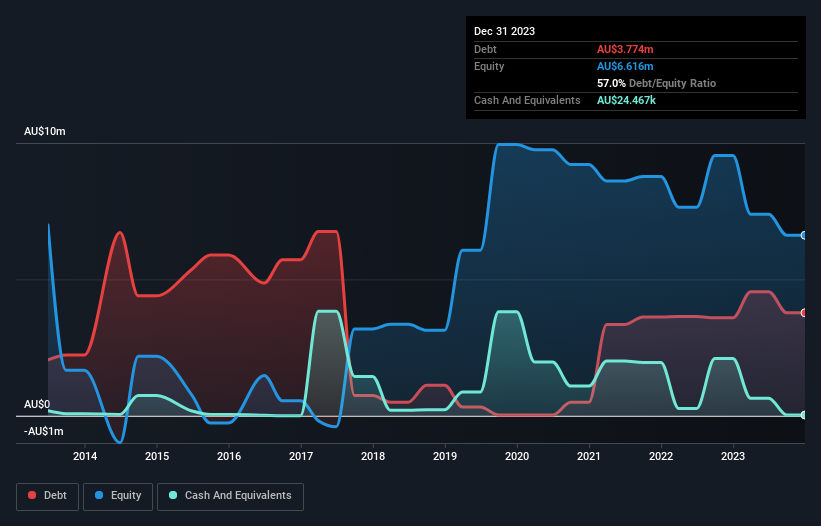Legendary fund manager Li Lu (who Charlie Munger backed) once said, 'The biggest investment risk is not the volatility of prices, but whether you will suffer a permanent loss of capital.' So it might be obvious that you need to consider debt, when you think about how risky any given stock is, because too much debt can sink a company. As with many other companies Memphasys Limited (ASX:MEM) makes use of debt. But is this debt a concern to shareholders?
When Is Debt A Problem?
Debt assists a business until the business has trouble paying it off, either with new capital or with free cash flow. In the worst case scenario, a company can go bankrupt if it cannot pay its creditors. While that is not too common, we often do see indebted companies permanently diluting shareholders because lenders force them to raise capital at a distressed price. Of course, plenty of companies use debt to fund growth, without any negative consequences. The first thing to do when considering how much debt a business uses is to look at its cash and debt together.
See our latest analysis for Memphasys
What Is Memphasys's Debt?
As you can see below, at the end of December 2023, Memphasys had AU$3.77m of debt, up from AU$3.59m a year ago. Click the image for more detail. And it doesn't have much cash, so its net debt is about the same.

A Look At Memphasys' Liabilities
The latest balance sheet data shows that Memphasys had liabilities of AU$4.87m due within a year, and liabilities of AU$1.66m falling due after that. Offsetting this, it had AU$24.5k in cash and AU$1.32m in receivables that were due within 12 months. So its liabilities outweigh the sum of its cash and (near-term) receivables by AU$5.19m.
This deficit isn't so bad because Memphasys is worth AU$12.3m, and thus could probably raise enough capital to shore up its balance sheet, if the need arose. However, it is still worthwhile taking a close look at its ability to pay off debt. When analysing debt levels, the balance sheet is the obvious place to start. But you can't view debt in total isolation; since Memphasys will need earnings to service that debt. So if you're keen to discover more about its earnings, it might be worth checking out this graph of its long term earnings trend.
Given it has no significant operating revenue at the moment, shareholders will be hoping Memphasys can make progress and gain better traction for the business, before it runs low on cash.
Caveat Emptor
Importantly, Memphasys had an earnings before interest and tax (EBIT) loss over the last year. Indeed, it lost a very considerable AU$4.0m at the EBIT level. Considering that alongside the liabilities mentioned above does not give us much confidence that company should be using so much debt. Quite frankly we think the balance sheet is far from match-fit, although it could be improved with time. However, it doesn't help that it burned through AU$3.8m of cash over the last year. So in short it's a really risky stock. The balance sheet is clearly the area to focus on when you are analysing debt. But ultimately, every company can contain risks that exist outside of the balance sheet. For example, we've discovered 6 warning signs for Memphasys (5 don't sit too well with us!) that you should be aware of before investing here.
If, after all that, you're more interested in a fast growing company with a rock-solid balance sheet, then check out our list of net cash growth stocks without delay.
New: Manage All Your Stock Portfolios in One Place
We've created the ultimate portfolio companion for stock investors, and it's free.
• Connect an unlimited number of Portfolios and see your total in one currency
• Be alerted to new Warning Signs or Risks via email or mobile
• Track the Fair Value of your stocks
Have feedback on this article? Concerned about the content? Get in touch with us directly. Alternatively, email editorial-team (at) simplywallst.com.
This article by Simply Wall St is general in nature. We provide commentary based on historical data and analyst forecasts only using an unbiased methodology and our articles are not intended to be financial advice. It does not constitute a recommendation to buy or sell any stock, and does not take account of your objectives, or your financial situation. We aim to bring you long-term focused analysis driven by fundamental data. Note that our analysis may not factor in the latest price-sensitive company announcements or qualitative material. Simply Wall St has no position in any stocks mentioned.
About ASX:MEM
Memphasys
Develops, manufactures, and sells cell and protein separation devices, and related consumables for the healthcare, veterinary, and biotechnology market sectors in Australia.
Moderate risk with mediocre balance sheet.
Market Insights
Community Narratives




